Effect of Low Annealing Temperature on the Critical-Current Density of 2% C-Doped MgB2 Wires Used in Superconducting Coils with the Wind-and-React (W&R) Method—High-Field and High-Temperature Pinning Centers
Abstract
:1. Introduction
2. Materials and Methods
3. Results and Discussion
3.1. Structural Analysis of Straight 2% C-Doped MgB2 Wires and Small 2% C-Doped MgB2 Coils
3.2. Irreversible-Magnetic-Field Analysis of Straight 2% C-Doped MgB2 Wires and Small 2% C-Doped MgB2 Coils
3.3. Critical-Current Density in Straight 2% C-Doped MgB2 Wires and Small 2% C-Doped MgB2 Coils
3.3.1. Jc and Jec at 4.2 K
3.3.2. Jc at 20 K, 25 K, and 30 K
4. Conclusions
Author Contributions
Funding
Institutional Review Board Statement
Informed Consent Statement
Data Availability Statement
Conflicts of Interest
References
- Zhang, Y.; Liu, W.; Zhu, X.; Zhao, H.; Hu, Z.; He, C.; Wen, H.H. Unprecedented high irreversibility line in the nontoxic cuprate superconductor (Cu,C)Ba2Ca3Cu4O11+δ. Sci. Adv. 2018, 4, 0192. [Google Scholar] [CrossRef]
- Galluzzi, A.; Buchkov, K.; Tomov, V.; Nazarova, E.; Leo, A.; Grimaldi, G.; Polichetti, M. High pinning force values of a Fe (Se, Te) Single crystal presenting a second magnetization peak phenomenon. Materials 2021, 14, 5214. [Google Scholar] [CrossRef]
- Moon, I.Y.; Kim, S.J.; Lee, H.W.; Jung, J.; Oh, Y.S.; Kang, S.H. Investigation of the correlation between initial microstructure and critical current density of Nb-46.5 wt%Ti superconducting material. Metals 2021, 11, 777. [Google Scholar] [CrossRef]
- Bovone, G.; Buta, F.; Lonardo, F.; Bagni, T.; Bonura, M.; LeBoeuf, D.; Hopkins, S.C.; Boutboul, T.; Ballarino, A.; Senatore, C. Effects of the oxygen source configuration on the superconducting properties of internally-oxidized internal-Sn Nb3Sn wires. Supercond. Sci. Technol. 2023, 36, 095018. [Google Scholar] [CrossRef]
- Yagaia, T.; Mizunoa, S.; Okuboa, T.; Mizuochia, S.; Kamibayashia, M.; Jimboa, M.; Takaoa, T.; Hiranob, N.; Makidac, Y.; Shintomic, T.; et al. Development of design for large scale conductors and coils using MgB2 for superconducting magnetic energy storage device. Cryogenics 2018, 96, 75–82. [Google Scholar] [CrossRef]
- Buzea, C.; Yamashita, T. Review of superconducting properties of MgB2. Supercond. Sci. Technol. 2001, 14, R115–R146. [Google Scholar] [CrossRef]
- Sumption, M.D.; Bhatia, M.; Rindfleisch, M.; Tomsic, M.; Collings, E.W. Transport and magnetic Jc of MgB2 strands and small helical coils. Appl. Phys. Lett. 2005, 86, 102501–102516. [Google Scholar] [CrossRef]
- Tanaka, K.; Kitaguchi, H.; Kumakura, H.; Yamada, H.; Hirakawa, M.; Okada, M. Fabrication and transport properties of an MgB2 solenoid coil. Supercond. Sci. Technol. 2005, 18, 678–681. [Google Scholar] [CrossRef]
- Serquis, A.; Civale, L.; Coulter, J.Y.; Hammon, D.L.; Liao, X.Z.; Zhu, Y.T.; Peterson, D.E.; Mueller, F.M.; Nesterenko, V.F.; Indrakanti, S.S. Large field generation with a hot isostatically pressed powder-in-tube MgB2 coil at 25 K. Supercond. Sci. Technol. 2004, 17, L35–L37. [Google Scholar] [CrossRef]
- Iwasa, Y. Towards liquid-helium-free, persistent-mode MgB2 MRI magnets: FBML experience. Supercond. Sci. Technol. 2017, 30, 053001. [Google Scholar] [CrossRef] [PubMed]
- Soltanian, S.; Horvat, J.; Wang, X.L.; Tomsic, M.; Dou, S.X. Transport critical current of solenoidal MgB2/Cu coils fabricated using a wind-reaction in situ technique. Supercond. Sci. Technol. 2003, 16, L4–L6. [Google Scholar] [CrossRef]
- Gajda, D.; Zaleski, A.J.; Morawski, A.; Cetner, T.; Rindfleisch, M. The influence of wire bending and wire diameter on transport critical current density in small MgB2 superconducting coils for applications in multi-section coils. J. Supercond. Nov. Magn. 2020, 33, 3395–3399. [Google Scholar] [CrossRef]
- Tomsic, M.; Rindflesich, M.; Yue, J.; McFadden, K.; Phillip, J.; Sumption, M.D.; Bhatia, M.; Bohnenstiehl, S.; Collings, E.W. Overview of MgB2 Superconductor Applications. Int. J. Appl. Ceram. Technol. 2007, 4, 250–259. [Google Scholar] [CrossRef]
- Pelissier, J.L. Determination of the phase diagram of magnesium: A model-potential approach in the sub-megabar range. Phys. Scr. 1986, 34, 838–842. [Google Scholar] [CrossRef]
- Gajda, D.; Zaleski, A.; Morawski, A.; Cetner, T.; Thong, C.J.; Rindfleisch, M.A. Point pinning centers in SiC doped MgB2 wires after HIP. Supercond. Sci. Technol. 2016, 29, 085010. [Google Scholar] [CrossRef]
- Katsura, Y.; Shimoyama, J.; Yamamoto, A.; Horii, S.; Kishio, K. Effects of rare earth doping on the superconducting properties of MgB2. Physica C 2007, 463–465, 225–228. [Google Scholar] [CrossRef]
- Wang, X.L.; Soltanian, S.; James, M.; Qin, M.J.; Horvat, J.; Yao, Q.W.; Liu, H.K.; Dou, S.X. Significant enhancement of critical current density and flux pinning in MgB2 with nano-SiC, Si, and C doping. Physica C 2004, 408–410, 63–69. [Google Scholar] [CrossRef]
- Woźniak, M.; Juda, K.L.; Hopkins, S.C.; Gajda, D.; Glowacki, B.A. Optimization of the copper addition to the core of in situ Cu-sheathed MgB2 wires. Supercond. Sci. Technol. 2013, 26, 105008. [Google Scholar] [CrossRef]
- Shahabuddin, M.; Madhar, N.A.; Alzayed, N.S.; Asif, M. Uniform dispersion and exfoliation of multi-walled carbon nanotubes in CNT-MgB2 superconductor composites using surfactants. Materials 2019, 12, 3044. [Google Scholar] [CrossRef]
- Yeoh, W.K.; Cui, X.Y.; Gault, B.; De Silva, K.S.B.; Xu, X.; Liu, H.W.; Yen, H.-W.; Wong, D.; Bao, P.; Larson, D.J.; et al. On the roles of graphene oxide doping for enhanced supercurrent in MgB2 based superconductors. Nanoscale 2014, 6, 6166. [Google Scholar] [CrossRef]
- Xu, H.L.; Feng, Y.; Xu, Z.; Yan, G.; Li, C.S.; Mossang, E.; Sulpice, A. Effects of TiB2 doping on the critical current density of MgB2 wires. Physica C 2006, 443, 5–8. [Google Scholar] [CrossRef]
- Kazakov, S.M.; Puzniak, R.; Rogacki, K.; Mironov, A.V.; Zhigadlo, N.D.; Jun, J.; Soltmann, Ch.; Batlogg, G.; Karpinski, J. Carbon substitution in MgB2 single crystals: Structural and superconducting properties. Phys. Rev. B 2005, 71, 024533. [Google Scholar] [CrossRef]
- Lim, J.H.; Shim, J.H.; Choi, J.H.; Park, J.H.; Kim, W.; Joo, J.; Kim, C.J. Effects of nano-carbon doping and sintering temperature on microstructure and properties of MgB2. Physica C 2009, 469, 15–20. [Google Scholar] [CrossRef]
- Gajda, D.; Zaleski, A.; Morawski, A.; Hossain, M.S.A. New types of high field pinning centers and pinning centers for the peak effect. Supercond. Sci. Technol. 2017, 30, 085011. [Google Scholar] [CrossRef]
- Huang, X.; Mickelson, W.; Regan, B.C.; Zettl, A. Enhancement of the upper critical field of MgB2 by carbon-doping. Solid State Commun. 2005, 136, 278–282. [Google Scholar] [CrossRef]
- Serquis, A.; Civale, L.; Hammon, D.L.; Liao, X.Z.; Coulter, J.Y.; Zhu, Y.T.; Jaime, M.; Peterson, D.E.; Mueller, F.M.; Nesterenko, V.F.; et al. Hot isostatic pressing of powder in tube MgB2 wires. Appl. Phys. Lett. 2003, 82, 2847. [Google Scholar] [CrossRef]
- Gajda, D.; Zaleski, A.J.; Morawski, A.; Rindfleisch, M.; Thong, C.; Tomsic, M. The electric field jump—Detection of damaged Nb barrier in MgB2 wires annealed under pressure. Supercond. Sci. Technol. 2015, 28, 115003. [Google Scholar] [CrossRef]
- Gajda, D.; Morawski, A.; Zaleski, A.; Yamamoto, A.; Cetner, T. A defect detection method for MgB2 superconducting and iron-based Ba(Fe,Co)2As2 wires. Appl. Phys. Lett. 2016, 108, 152601. [Google Scholar] [CrossRef]
- Hapip, N.M.; Miryala, M.; Chen, S.K.; Arvapalli, S.S.; Murakami, M.; Kechik, M.M.A.; Tan, K.B.; Lee, O.J. Enhancement of critical current density for MgB2 prepared using carbon-encapsulated boron with co-addition of Dy2O3 and La2O3. Ceram. Int. 2020, 46, 23041–23048. [Google Scholar] [CrossRef]
- Ghorbani, S.R.; Wang, X.L.; Hossain, M.S.A.; Dou, S.X.; Lee, S.-I. Coexistence of the δl and δTc flux pinning mechanisms in nano–Si–doped MgB2. Supercond. Sci. Technol. 2010, 23, 025019. [Google Scholar] [CrossRef]
- Rydh, A.; Welp, U.; Hiller, J.M.; Koshelev, A.E.; Kwok, W.K.; Crabtree, G.W. Surface contribution to the superconducting properties of MgB2 single crystals. Phys. Rev. B 2003, 68, 172502. [Google Scholar] [CrossRef]
- Wang, D.; Ma, Y.; Yao, C.; Xu, D.; Zhang, X.; Awaji, S. Transport properties of multifilament MgB2 long wires and coils prepared by an internal Mg diffusion process. Supercond. Sci. Technol. 2017, 30, 064003. [Google Scholar] [CrossRef]
- Gajda, D.; Zaleski, A.J.; Morawski, A.; Czujko, T.; Avci, D.; Karaboga, F.; Akdogan, M.; Yetis, H.; Cetner, T.; Belenli, I. The significant influence of packing density of unreacted Mg+ 2B mixture and heat treatment conditions on some of critical parameters for MgB2/Fe wires. J. Alloys Comp. 2021, 889, 161665. [Google Scholar] [CrossRef]
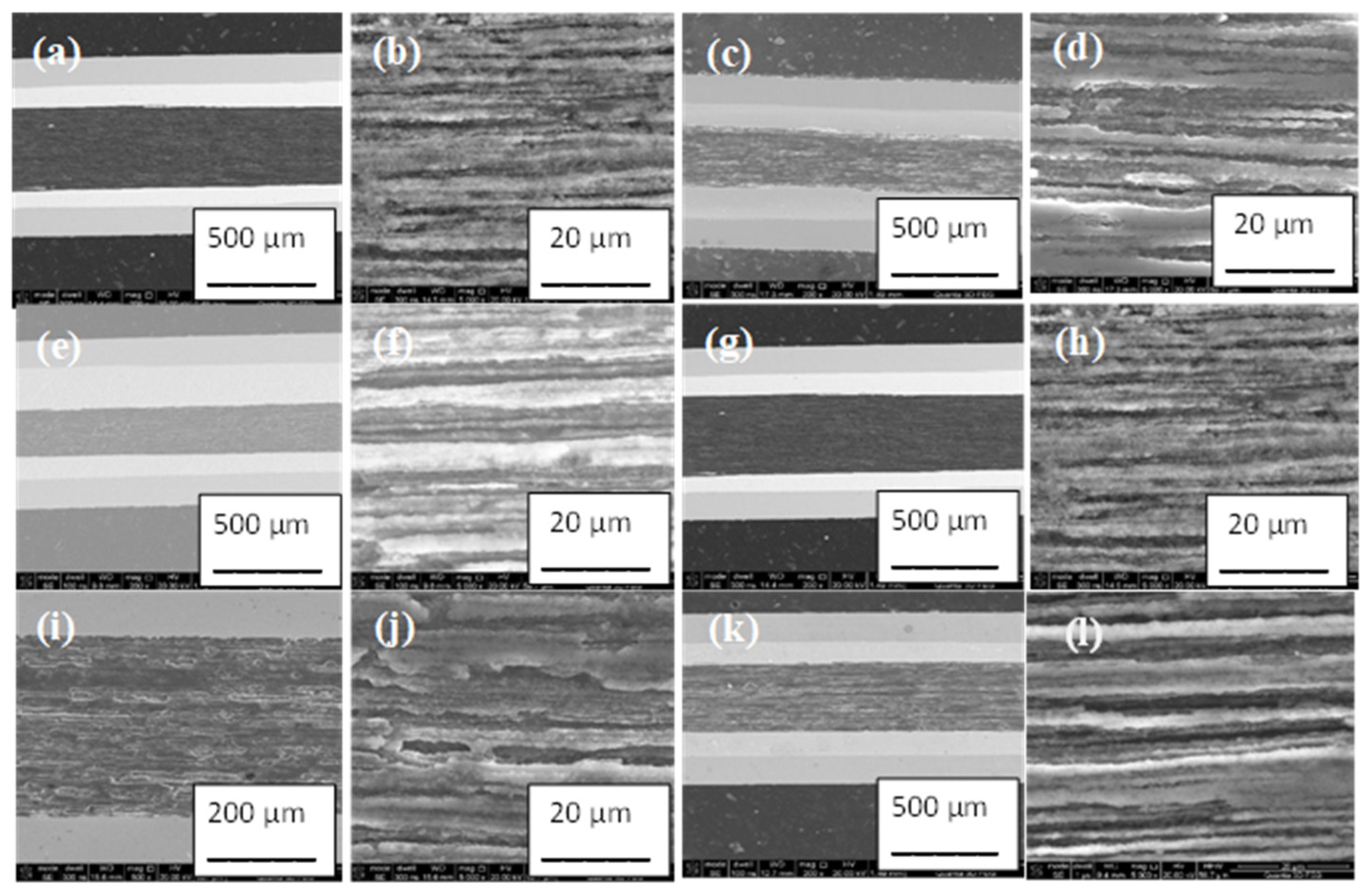
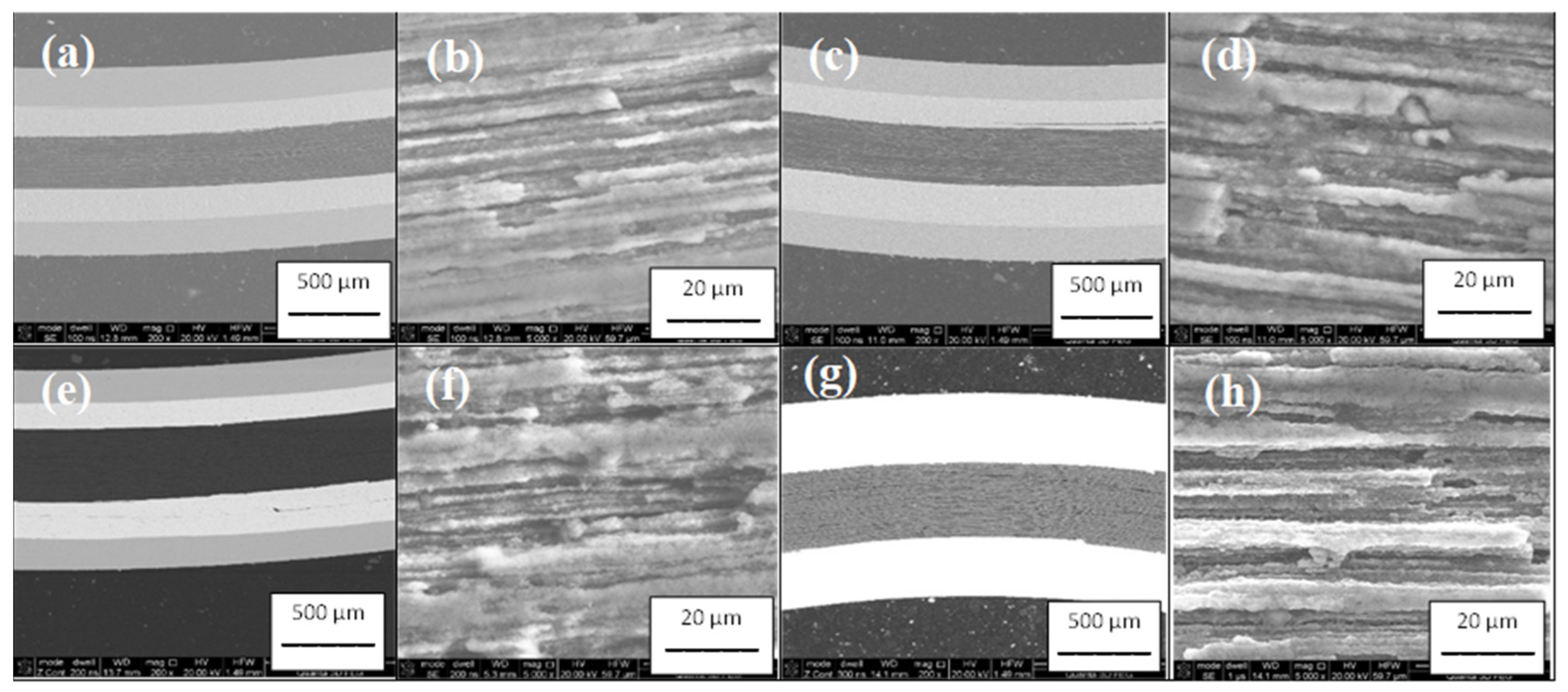
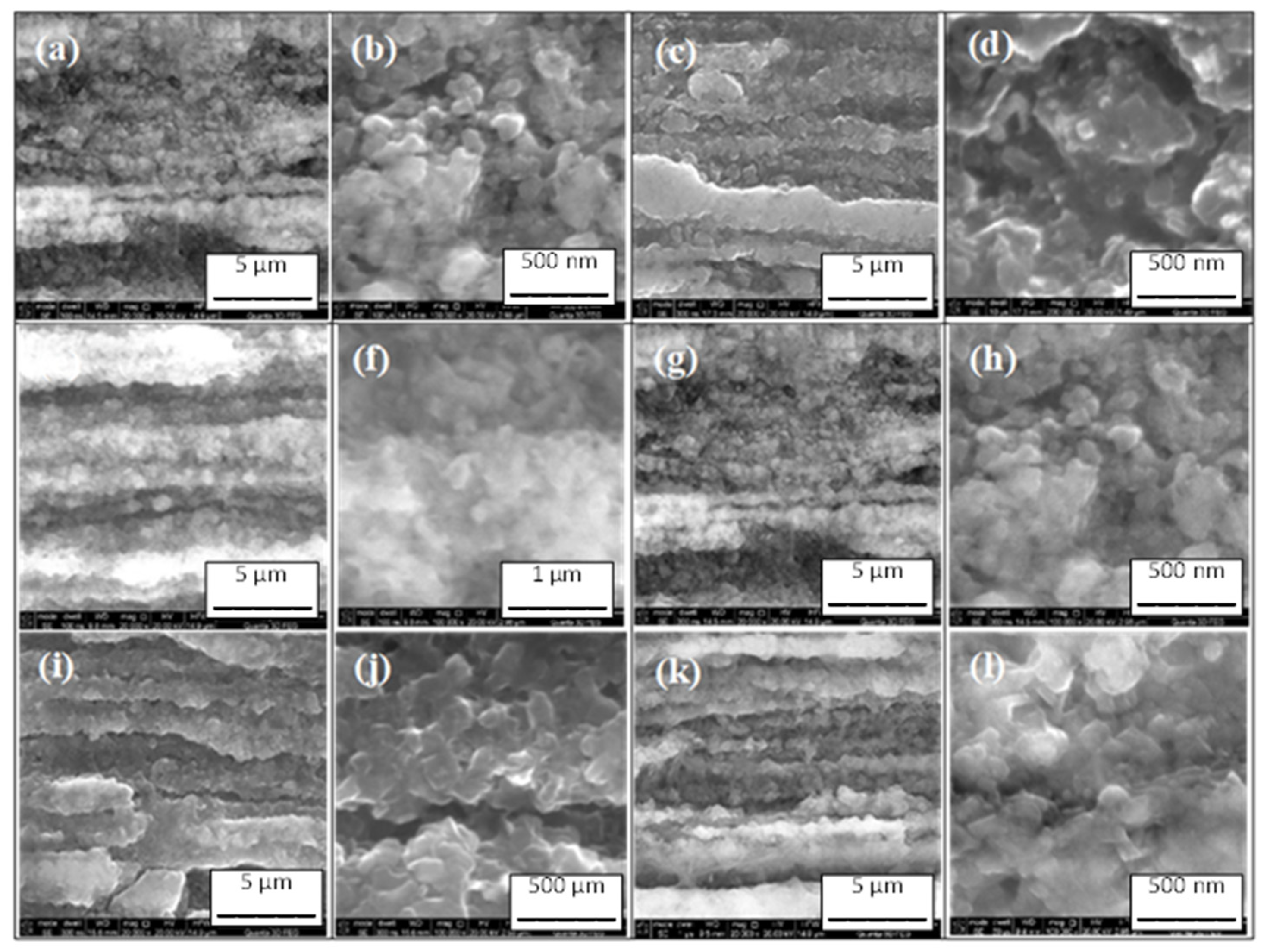
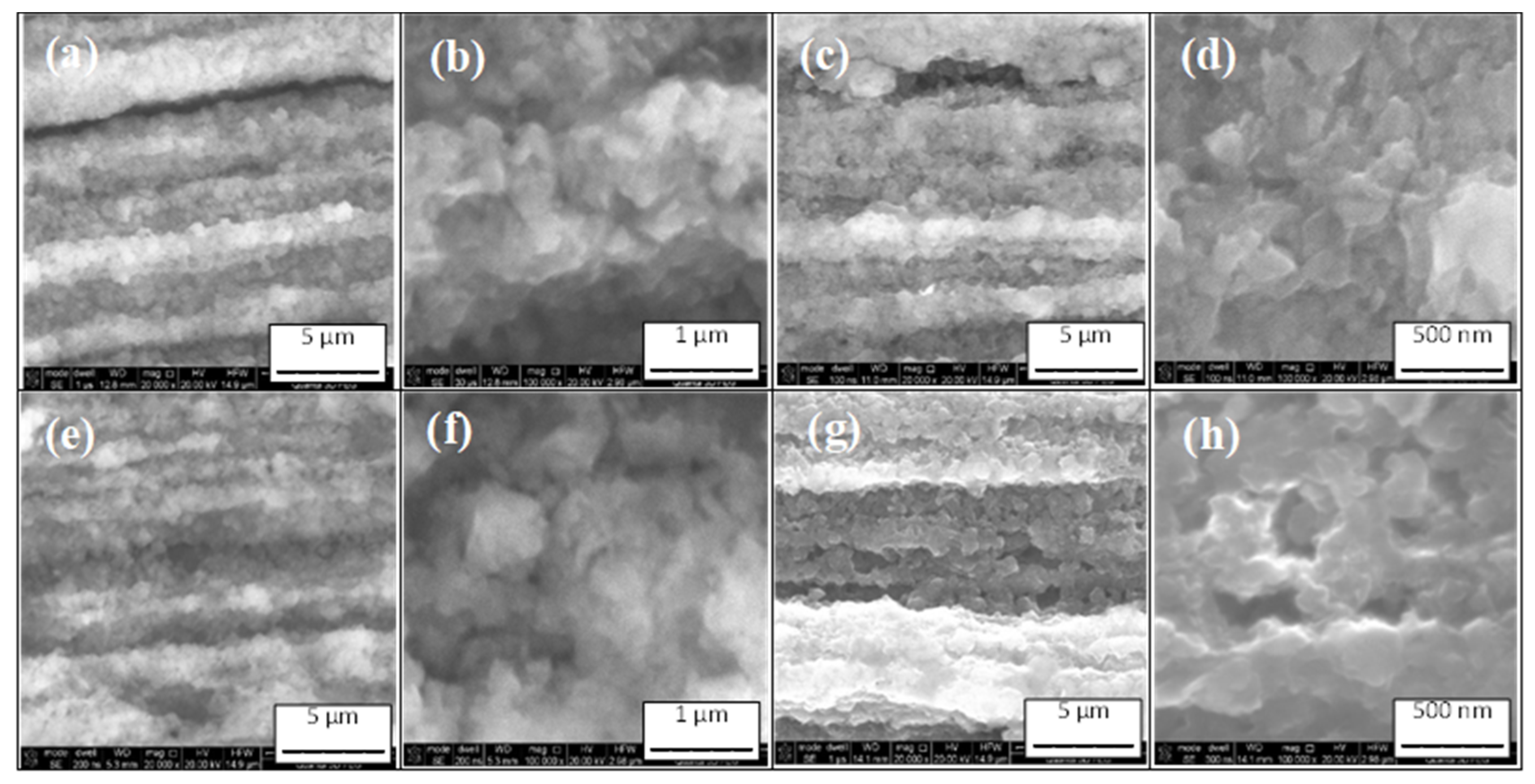
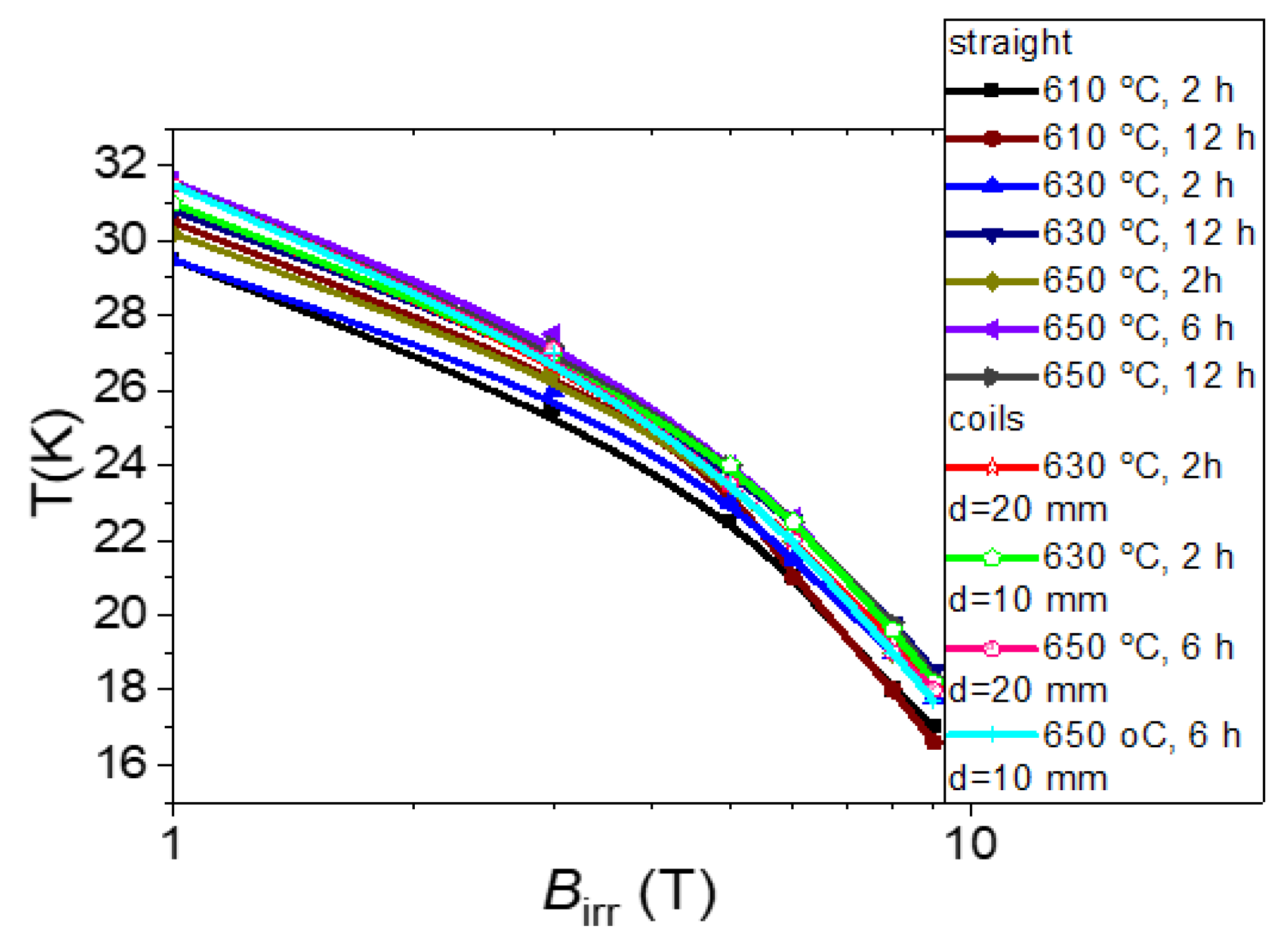
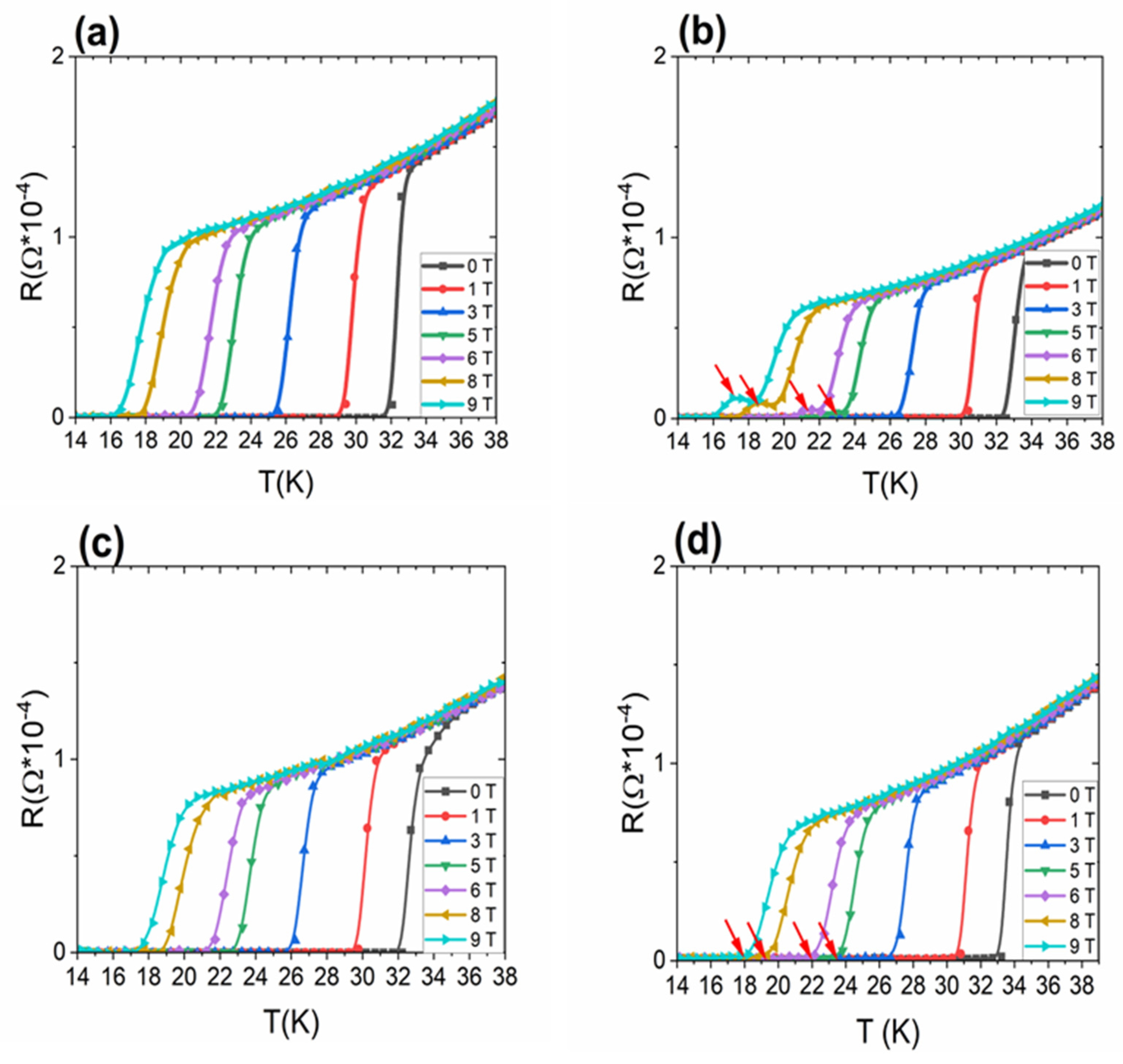
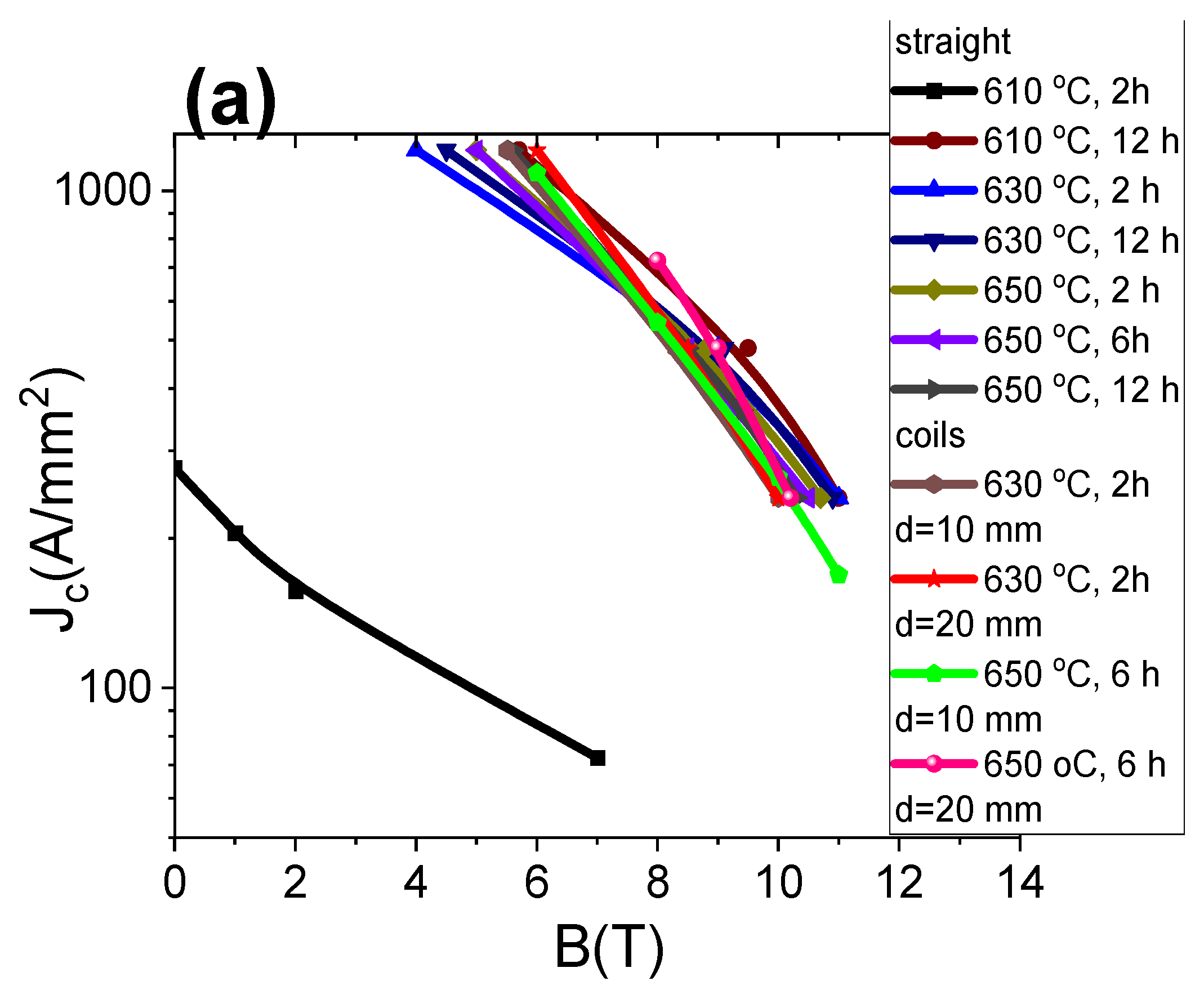
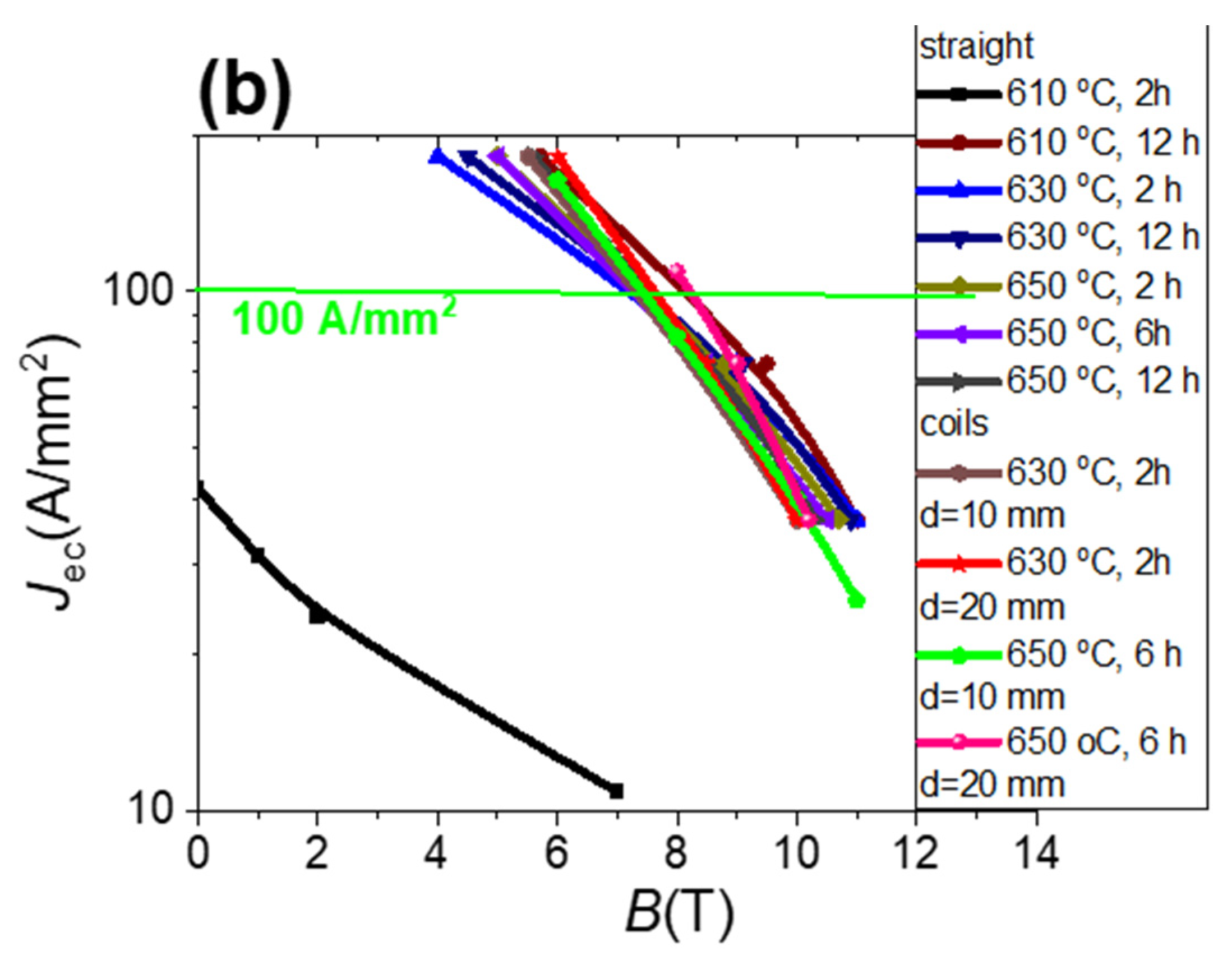
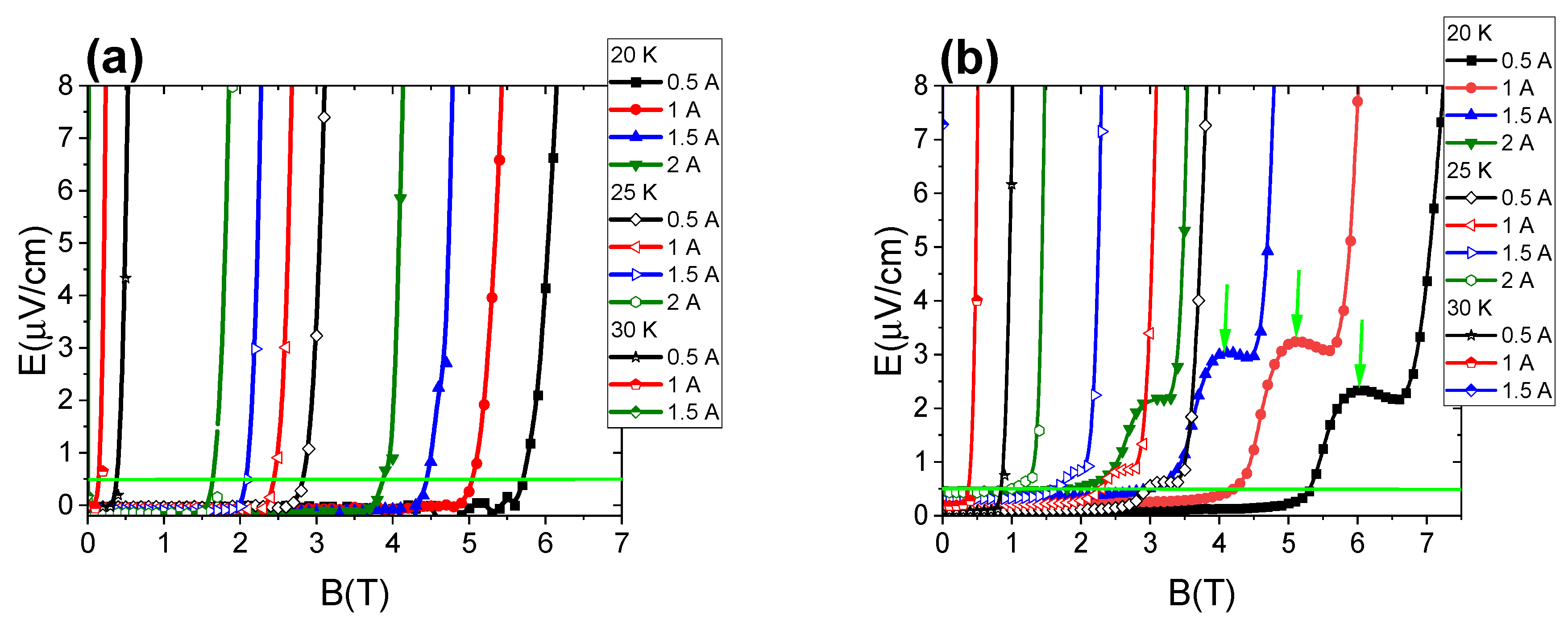
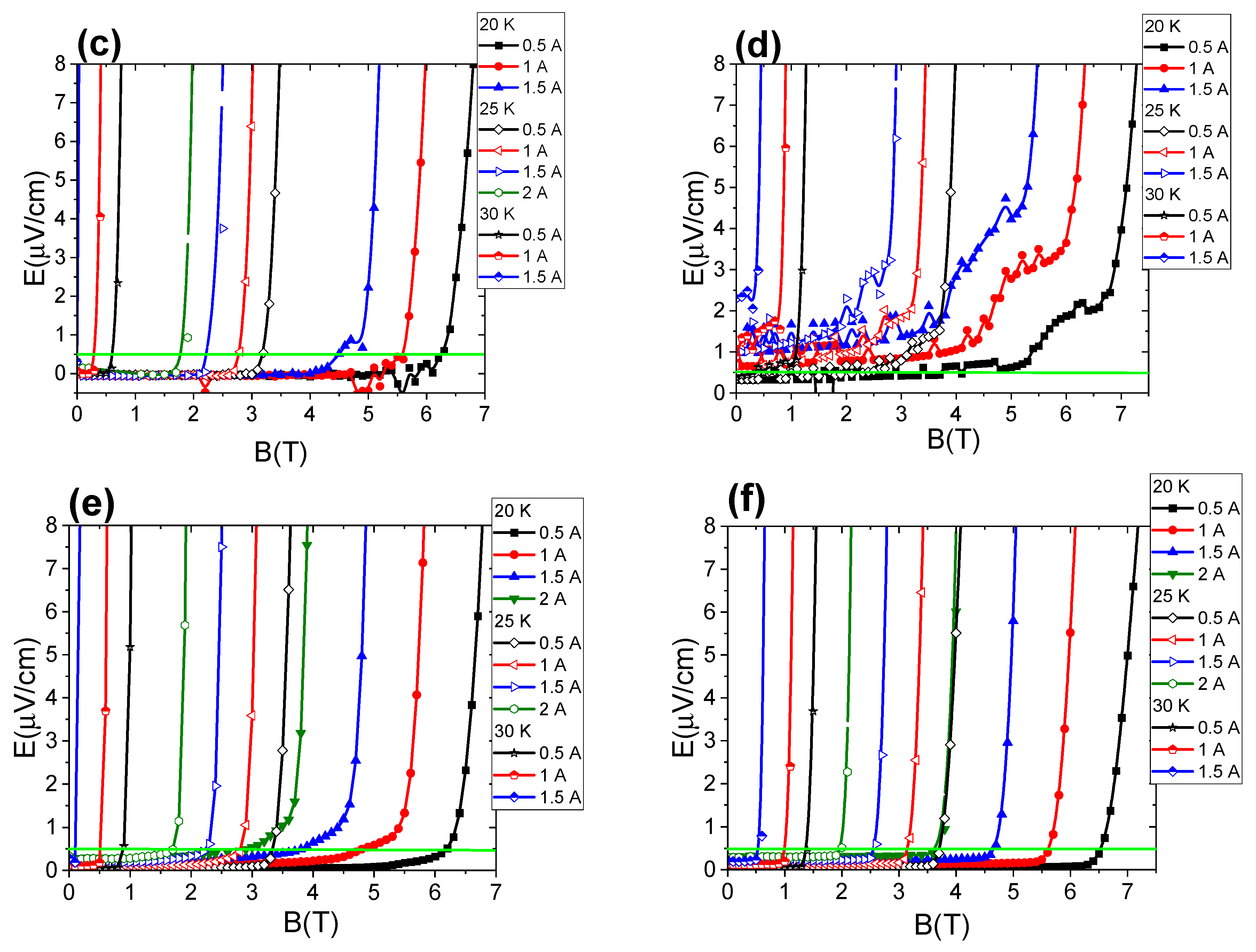
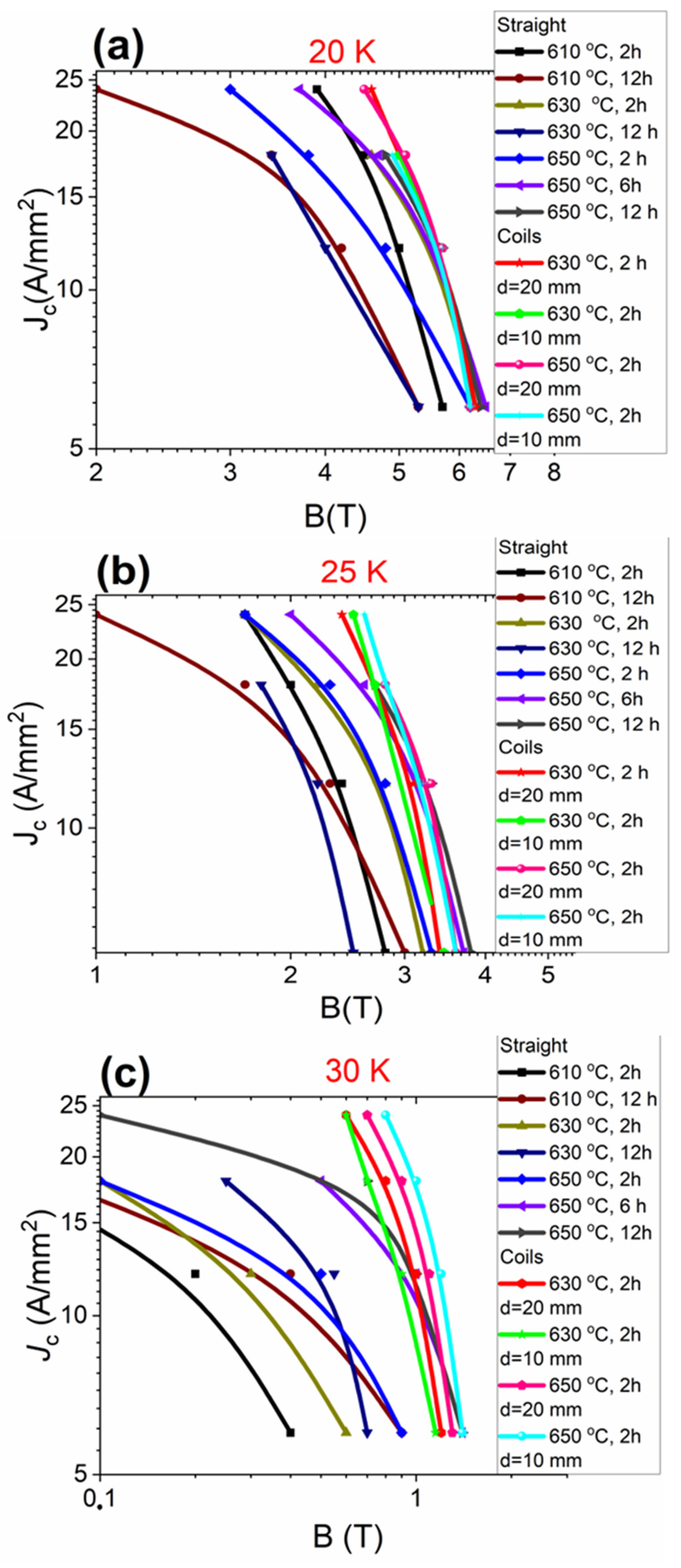
Disclaimer/Publisher’s Note: The statements, opinions and data contained in all publications are solely those of the individual author(s) and contributor(s) and not of MDPI and/or the editor(s). MDPI and/or the editor(s) disclaim responsibility for any injury to people or property resulting from any ideas, methods, instructions or products referred to in the content. |
© 2023 by the authors. Licensee MDPI, Basel, Switzerland. This article is an open access article distributed under the terms and conditions of the Creative Commons Attribution (CC BY) license (https://creativecommons.org/licenses/by/4.0/).
Share and Cite
Czujko, T.; Gajda, D.; Rindfleisch, M.; Babij, M.; Zaleski, A. Effect of Low Annealing Temperature on the Critical-Current Density of 2% C-Doped MgB2 Wires Used in Superconducting Coils with the Wind-and-React (W&R) Method—High-Field and High-Temperature Pinning Centers. Materials 2023, 16, 6157. https://doi.org/10.3390/ma16186157
Czujko T, Gajda D, Rindfleisch M, Babij M, Zaleski A. Effect of Low Annealing Temperature on the Critical-Current Density of 2% C-Doped MgB2 Wires Used in Superconducting Coils with the Wind-and-React (W&R) Method—High-Field and High-Temperature Pinning Centers. Materials. 2023; 16(18):6157. https://doi.org/10.3390/ma16186157
Chicago/Turabian StyleCzujko, Tomasz, Daniel Gajda, Matt Rindfleisch, Michał Babij, and Andrzej Zaleski. 2023. "Effect of Low Annealing Temperature on the Critical-Current Density of 2% C-Doped MgB2 Wires Used in Superconducting Coils with the Wind-and-React (W&R) Method—High-Field and High-Temperature Pinning Centers" Materials 16, no. 18: 6157. https://doi.org/10.3390/ma16186157
APA StyleCzujko, T., Gajda, D., Rindfleisch, M., Babij, M., & Zaleski, A. (2023). Effect of Low Annealing Temperature on the Critical-Current Density of 2% C-Doped MgB2 Wires Used in Superconducting Coils with the Wind-and-React (W&R) Method—High-Field and High-Temperature Pinning Centers. Materials, 16(18), 6157. https://doi.org/10.3390/ma16186157






